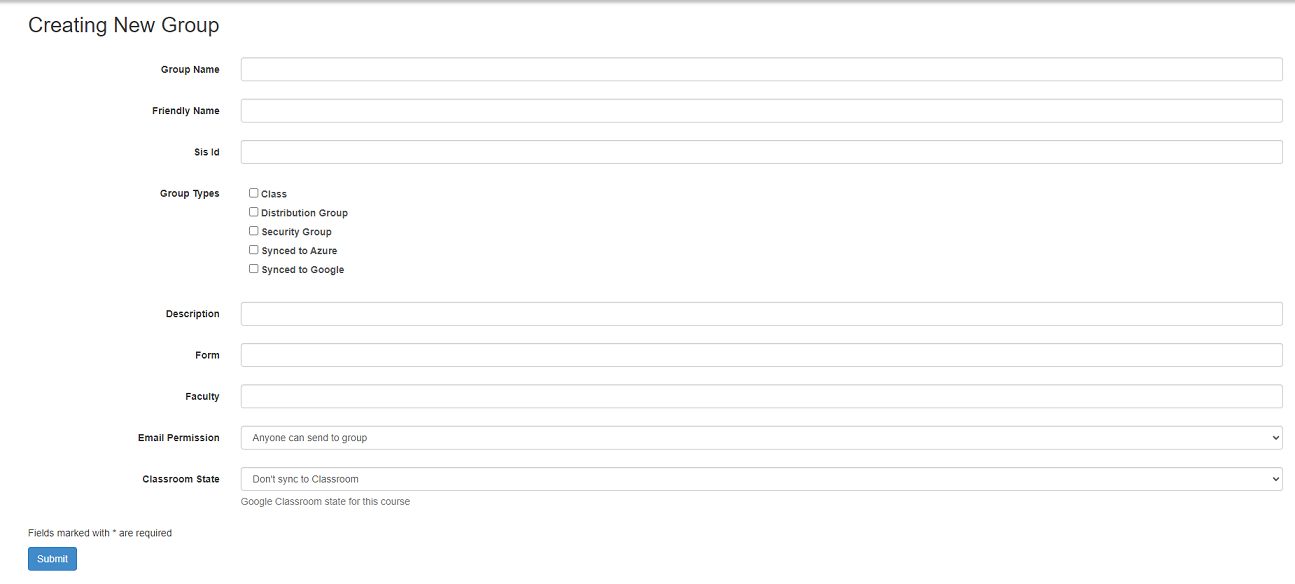Difference between revisions of "Groups"
Jrobertson (talk | contribs) |
|||
| Line 41: | Line 41: | ||
Your CSV file should contain the following headings: | Your CSV file should contain the following headings: | ||
Group Email Address, Member Email Address, Group Name | Group Email Address, Member Email Address, Group Name | ||
| + | |||
| + | It is important to keep in mind that when uploading a group of users - users that were manually added to groups by administrators are not automatically removed. | ||
Revision as of 00:40, 2 February 2022
'Groups' in Cloudwork can represent Security or Distribution groups that exist in your directory or School Management System (SMS).
They can also be manually created groups for sending emails, use by service providers or any number of other purposes.
Adding Groups
The following form displays:
- Group Name - Full name of the group. If this is intended to be an email distribution group this needs to be a full email address.
- Friendly Name - The name that will be displayed when using the group.
- Sis id -
- Group Types - The type of the group
- Class
- Distribution Group
- Security Group
- Synced to Azure - groups with this type will be synced to Azure
- Synced to Google - groups with this type will be synced to Google
- Description - A description that will only be visible to this dashboard for reference by administrators
- Form
- Faculty
- Email Permission - Permissions that apply to email groups as to who can send email to them. The options available are:
- Anyone can send to group
- Anyone within the domain can send to the group
- Only group members can post
- Only Teachers can post
- Classroom state - Google classroom state for this course. The options available are:
- Don’t sync to Classroom
- Provisioned
- Active
- Archived
- Declined
- Suspended
Bulk Group Upload
The other option for creating groups manually is through the bulk upload facility You can create a CSV file with the user account information using spreadsheet programs like Microsoft Excel or OpenOffice Calc.
Your CSV file should contain the following headings: Group Email Address, Member Email Address, Group Name
It is important to keep in mind that when uploading a group of users - users that were manually added to groups by administrators are not automatically removed.
e.g. Group Email Address, Member Email Address, Group Name
class-1@example.edu.au, a.student@example.edu.au, Class Number 1 class-2@example.edu.au, joeblogs@example.edu.au, Class Number 2 class-2@example.edu.au, a.student@example.edu.au, Class Number 2
The following groups will be created or added to:
Class Number 1: a.student@example.edu.au
Class Number 2: a.student@example.edu.au
joeblogs@example.edu.au
You can also replace the Member Email Address column with Member User Name
e.g. Group Email Address, Member User Name, Group Name
class-1@example.edu.au, astudent, Class Number 1 class-2@example.edu.au, jblogs, Class Number 2 class-2@example.edu.au, astudent, Class Number 2
The following groups will be created or added to:
Class Number 1: astudent
Class Number 2: astudent
jblogs
Bulk Send Welcome Message
After bulk uploading a group, we can send a Welcome Message to all users that are apart of that group.
- Navigate to Message Template
- Click on the Welcome Message Template.
- Click Send
- Under Attributes Select Groups
- Under Match enter group name
- Click continue
- Check users displayed are the users of the new group
- If the users shown are the intended users for receiving the Welcome Message click Continue to send the Welcome Message.
